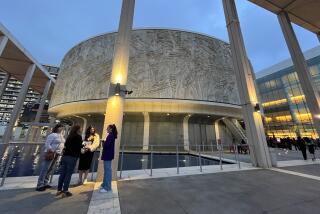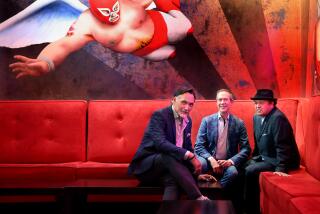To remain relevant, Music Center aims to reflect all of Los Angeles
Jascha Heifetz playing Beethoven was the main attraction on the Music Center’s opening night, Dec. 6, 1964. But before seeing the great violinist, concertgoers would have seen themselves, reflected in all their finery in the gigantic mirrors that line the Dorothy Chandler Pavilion’s lofty central staircase.
The staircase and the Pavilion’s other markers of classical European opulence still dazzle. But 50 years later, the Music Center has a very different awareness of the need to reflect its audience, and it can’t be done just with mirrors.
Its leaders recognize that to stay vital in the years ahead, L.A.’s first and most prestigious multiple-venue performing arts hub needs to mirror all of Los Angeles.
So come next season, the patrons taking in the Chandler Pavilion’s old-world splendor will include ticket holders at a weeklong hip-hop performance festival.
They’ll reflect how the Music Center’s conception of itself and its mission are changing.
“So much of our time and effort is looking to the future and how to remain relevant,” says Renae Williams Niles, the head of programming whose job includes finding and booking attractions, including the hip-hop festival, that will be meaningful and alluring to what she calls “a more globalized and diverse community.”
“How do we respond to that to ensure that we have longevity and continue to have a leadership role?” Williams Niles asks.
The answers are not simple. But as is usually the case with major nonprofit performing arts venues, they are expensive. Success ultimately will depend on whether L.A.’s economic elite will subsidize the kinds of programs that would make the Music Center a mirror rather than just mirrored.
Most expensive of all is a renovation of the Chandler Pavilion and the large outdoor plaza at its doorstep. These, along with neighboring Grand Park, are the primary spots for events and performances available to the Music Center if it wants to be an impresario searching for tomorrow’s audience instead of merely a landlord.
As landlord to four independent resident companies, the Music Center keeps the four theaters along Grand Avenue clean, safe and in good repair, and it makes sure the ushers it hires for all the performances are friendly and helpful.
With Walt Disney Concert Hall almost completely commandeered by the Los Angeles Philharmonic and the Los Angeles Master Chorale, and ditto for the Mark Taper Forum and the Ahmanson Theatre, where Center Theatre Group holds sway, the Music Center programming wing led by Williams Niles presents an annual ballet and contemporary dance series in the Chandler Pavilion. Otherwise, it has to book around performances, rehearsals or set-installations and teardowns by Los Angeles Opera, the 3,180-capacity hall’s main occupant.
All the resident companies are concerned with finding ways to reach the younger, more diverse audience on which the future of big-ticket performing arts in L.A. (and elsewhere) will hinge. Williams Niles thinks the Music Center organization has a special mandate along those lines.
Dance, the Music Center’s baby, has the greatest potential to reach the younger crowd, she says. And because the Music Center isn’t married to a particular arts discipline, Williams Niles think it can be the most flexible laboratory for experimentation.
“What’s proven to attract younger, more diverse audiences [are] things that are multidisciplinary, with dance and music and a use of technology and visual arts,” said Williams Niles, a former dancer with the Lula Washington Dance Theatre.
So that’s what she’s aiming for in seasons to come.
Williams Niles thinks the hip-hop festival, planned for spring 2016, could become a signature event, suitable for sending on tour to other performing arts centers dying to appeal to younger and more racially and ethnically mixed audiences.
“We’re looking at major collaborators, no one I can confirm just yet,” Williams Niles said of the festival’s talent roster. She envisions headliners performing in the Chandler Pavilion and Disney Hall, with the Music Center Plaza and Grand Park coming alive with the participatory programming — human beatboxing lessons, anybody?— that increasingly is a focus for the Music Center.
Heifetz on the Pavilion’s stage was cool, and his successors in the classical music and operatic limelight will always be welcome, but today’s Music Center leaders tend to get excited talking about how hundreds of ukulele players show up with their instruments for instructional workshops and jam sessions in the Pavilion’s lobby — where the decor includes a bust of Heifetz on a marble pedestal.
Kenneth Foster, a veteran performing arts venue director who heads a new arts leadership program at USC, applauds the Music Center for the arts-participation emphasis. “Counterintuitive as it may feel to people who are white and in their 60s, as I am, that is where the future is” for performing arts centers, he said.
The Music Center’s agenda also calls for presenting professional performers in unorthodox ways intended to project a youthful sense of adventure. Coming next fall is a new series tentatively called “Dark Nights” — an ironic appropriation of arts-venue slang for “the theater lights are off because nothing’s happening.” It will include an evening of dances tailored by L.A.-based choreographers for a variety of unorthodox spots around the Music Center, including an outdoor staircase near the Chandler Pavilion and the Founders Room, an elite, members-only inner sanctum at the Pavilion where the décor includes a selection of paintings on loan from Pasadena’s Norton Simon Museum.
The dream of reflecting the faces of Los Angeles won’t happen if these and other programs don’t also reflect what the typical Los Angeles family’s wallet, purse or bank account can accommodate.
The Music Center’s crowning fundraising achievement of recent years was landing a $20-million donation from dance lover Glorya Kaufman to endow its dance series. That endowment generates almost $1 million a year, Williams Niles said, but expenses are such that other donors must be counted on for an additional $1.2 million or more to meet an annual series budget of about $4 million. Box office proceeds generate only about half of what it costs to put on the shows, so without the donors prices would have to double to pay the whole freight, killing any prospects of the dance audience resembling anything like a cross section of the community.
So more programming that’s more adventurous and more affordable will mean all the more pressure on fundraising.
“The dance donors got excited” by the turn toward innovation that the “Dark Nights” series and hip-hop festival embody, Williams Niles said. She thinks they’ve grasped this new imperative that, if not met, could cast doubt on whether the future can hold many more milestone anniversaries.
“For the future relevance of the Music Center, the hope is [newcomers] don’t just come to one performance a year, but you feel this is your cultural home,” Williams Niles said. “That if you’re looking for an experience, this is where you come.”
Follow me on Twitter: @boehmm
More to Read
The biggest entertainment stories
Get our big stories about Hollywood, film, television, music, arts, culture and more right in your inbox as soon as they publish.
You may occasionally receive promotional content from the Los Angeles Times.







